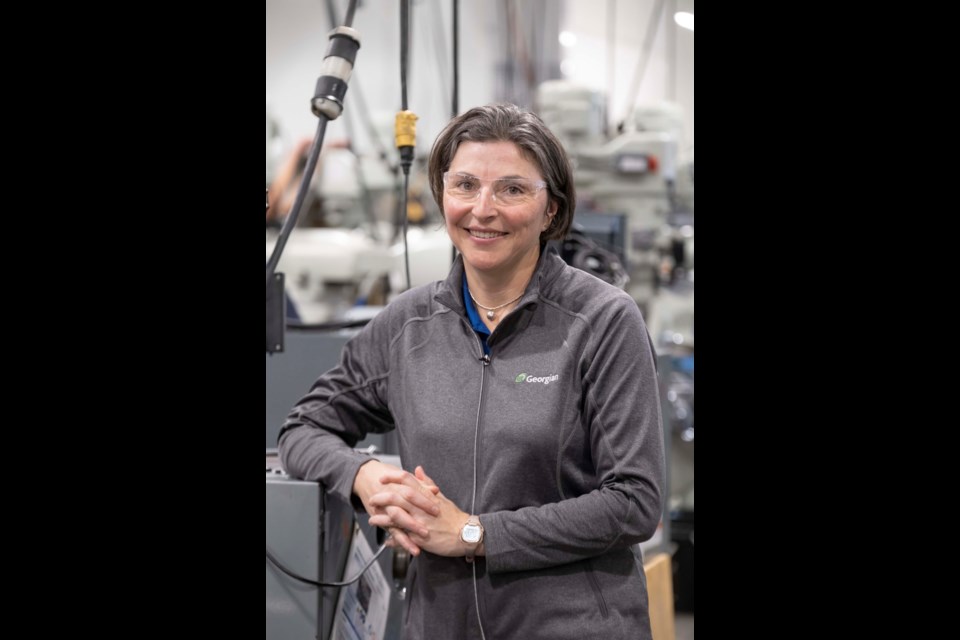When Rebecca Sabourin graduated as a mechanical engineer over two decades ago, she didn’t have all skills she needed to advance in her 27-year career as an aerospace engineer.
“I learned just mechanical systems. And then, once I got out into industry and worked on electronic warfare, I had to learn the electrical side and computer programming,” said Sabourin, who's now dean of engineering and environmental technologies and skilled trades at Georgian College.
The story helps illustrate the idea behind the electromechanical engineering technology – mechatronics program, which combines electrical, mechanical and computing systems.
“This interdisciplinary approach enables students to go and work in most industries,” Sabourin said.
The three-year program covers electronics, digital circuits, motor control, robotics, programmable logic controllers (PLCs), pneumatics, hydraulic systems, machining, dynamics, stress analysis, the internet of things, web and database systems, and interface programming.
“This program is very relevant, considering that we're in in the fourth industrial revolution, which is about interconnected systems and human-in-the-loop (HITL).”
More than that, Sabourin said the program uses a systems-based approach. For instance, she explained that instead learning the theoretical information of what a resistor is, students will learn what the common systems are.
“They will learn enough about common systems to slowly break it down into specific elements like resistors and capacitors and then, they learn to troubleshoot," she added.
The experiential learning program is supported by the Magna Mechatronics lab, which officially opened at the Barrie campus on June 23.
“The faculty can maybe put something up on the board, and then go right to the lab equipment and demonstrate it, or the other way around,” Sabourin explained.
Funded to a significant degree by auto parts manufacturer Magna International, the lab is designed to address emerging technologies, focusing on interconnectivity, automation, machine-learning, and real-time data.
The hands-on experience at the Magna Mechatronics lab includes interoperable systems, intelligent automation, and network systems and sensors, as well as some cyber-security and artificial intelligence.
Sabourin described the lab facility as a "magnificent" and "fully functioning lab."
“It's kind of a ‘mini-Lego environment’ where students will be able to model several types of tasks that they would see in a factory," she said.
The lab is equipped with different workstations, such as assembly, distribution and warehousing.
“Students will look at these assembly lines and figure out what they do, and then learn about the very specific components and scaffold that learning,” Sabourin said.
The facility houses various types of robots including collaborative robots, which work in tandem with humans, and industrial robots, like the ones that pick at cars at assembly lines.
The lab has also different types of processors, controllers and sensors, which are typically used for data collection and analysis, as well as just-in-time maintenance.
“We've been working with a lot of simulation, so students have the opportunity to really hone their skills in a simulated environment, and then actually do it for real afterwards,” she added.
Sabourin says she's passionate about a lot of hands-on experiences where her students get to interact with the equipment in the facility.
“In a lot of cases, these students do more incredible things with this equipment than we would have ever expected," she said.
Brett Wismer, employer relations consultant at Georgian College, noted that the program, which includes a four- or eight-month co-op component, is truly about "work integrated learning."
“Students will bring their experience on the job back to the classroom and then keep doing what they learned until they graduate," he said.
Wismer says there are a lot of third-party employers looking to hire students from the program. These include companies in sectors such as automotive, aerospace, pharmaceutical, and energy.
“Every semester, we have between 30 to 40 employers and they'll hire multiple students. I'm still learning about new ones because they're always reaching out and connecting with us," he added.
Wismer said robotics and automation play a big part in the program, and he sees a lot of students getting into the robotics field upon graduation.
“Employers are looking for that analytical mind. Somebody that can take a robot apart, figure out what's going on inside and how it works, and then put it back together successfully," he said.
For Sabourin, the program prepares students for successful careers beyond the factory floor, which include opportunities in research and innovation as well as in business-related areas.
“It would allow students that are creative and innovative to take this combination of learning and apply it towards the sustainable development goals," she said.
Sabourin believes the mechatronics program provides the critical knowledge needed to succeed in the evolving global industry.
“I think it's really the toolkit that students need to go out and look at climate disruption and what's going on," she said. "To look at all the relevant challenges that we're having nowadays and attack them."



